
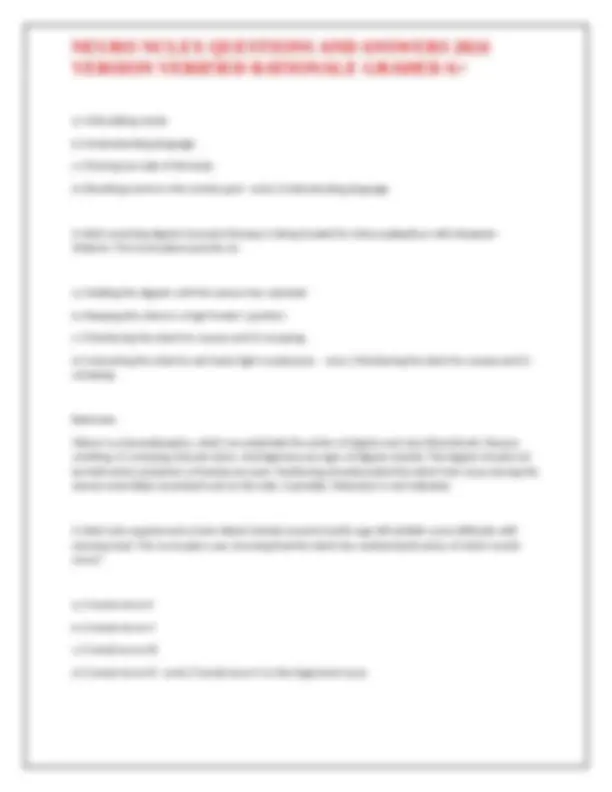
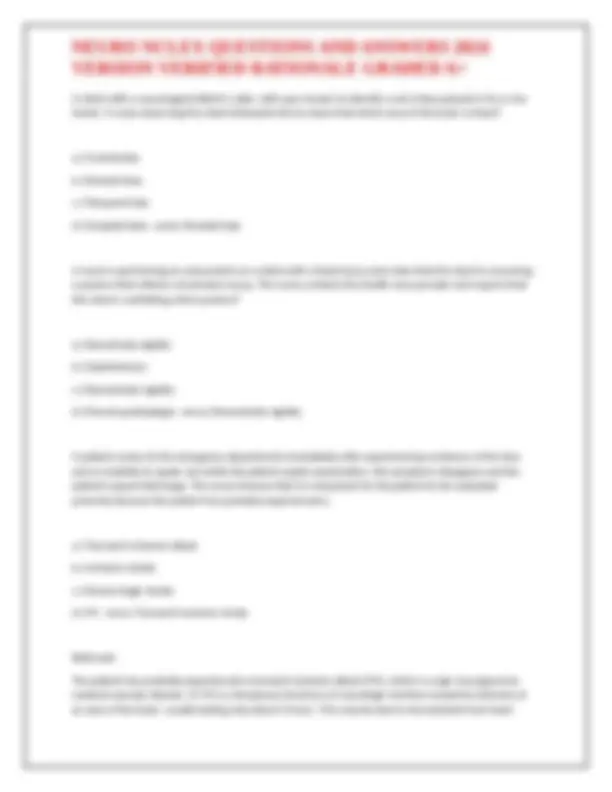
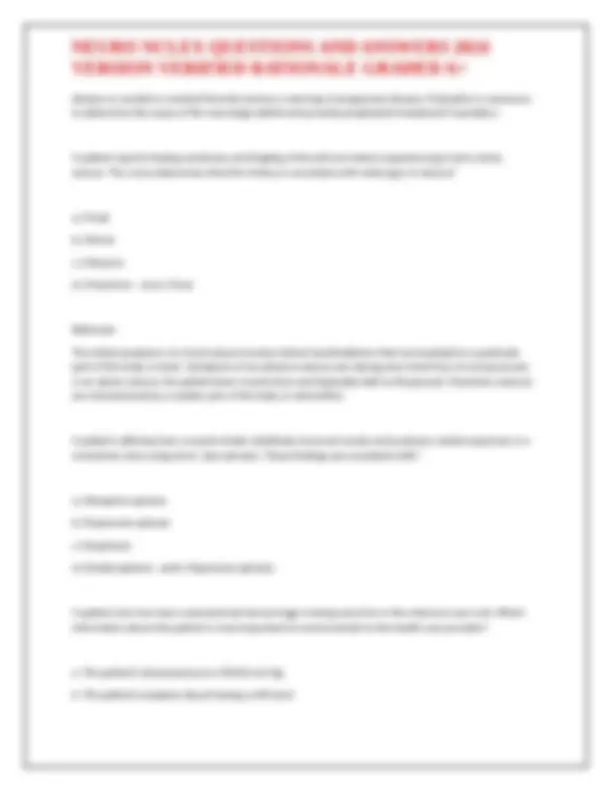
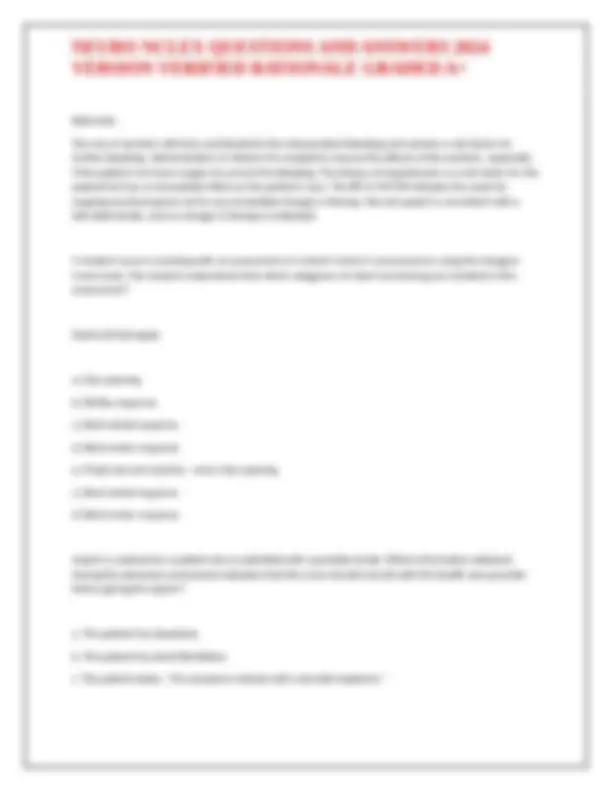
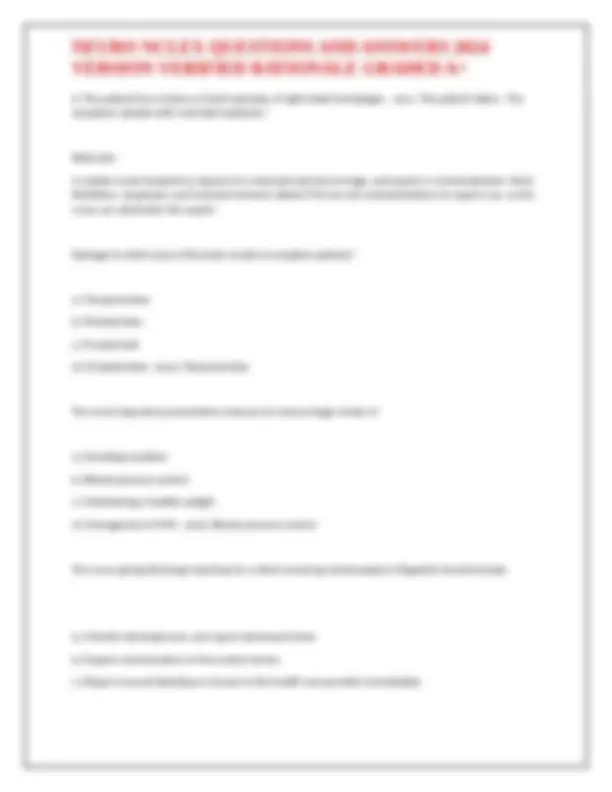
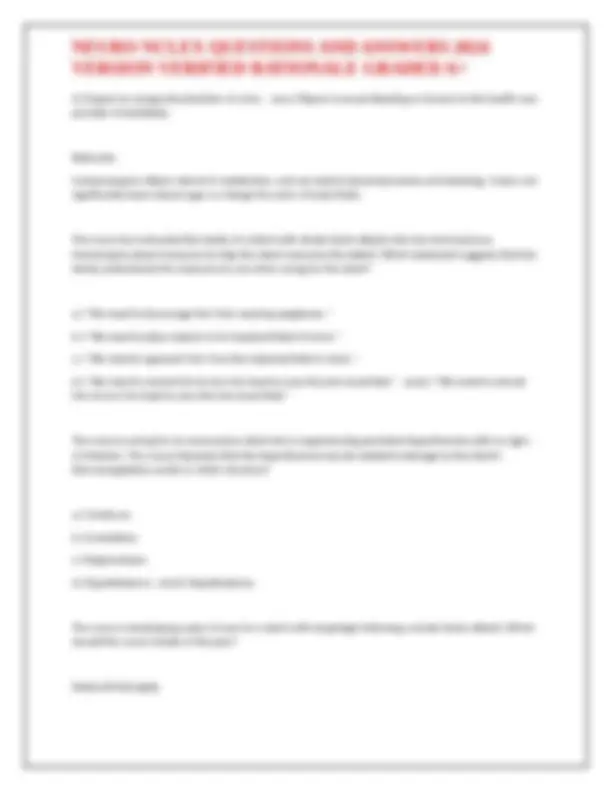
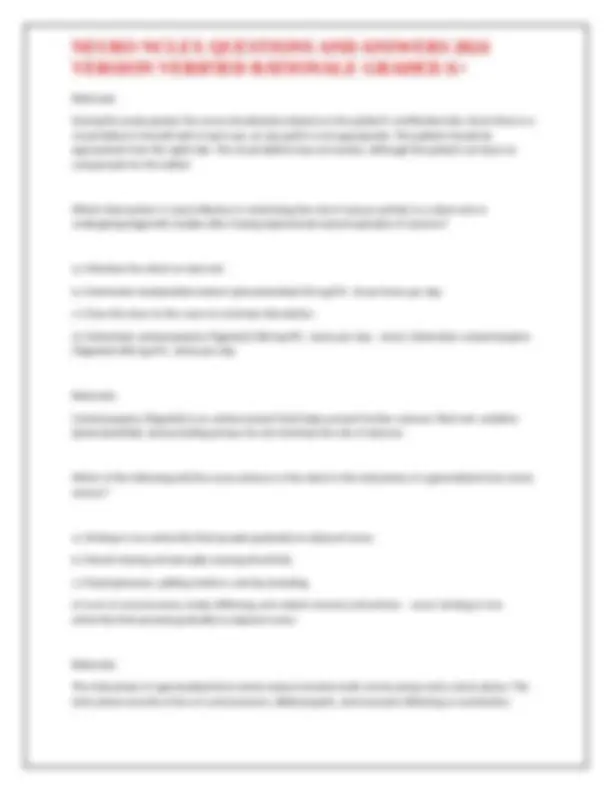
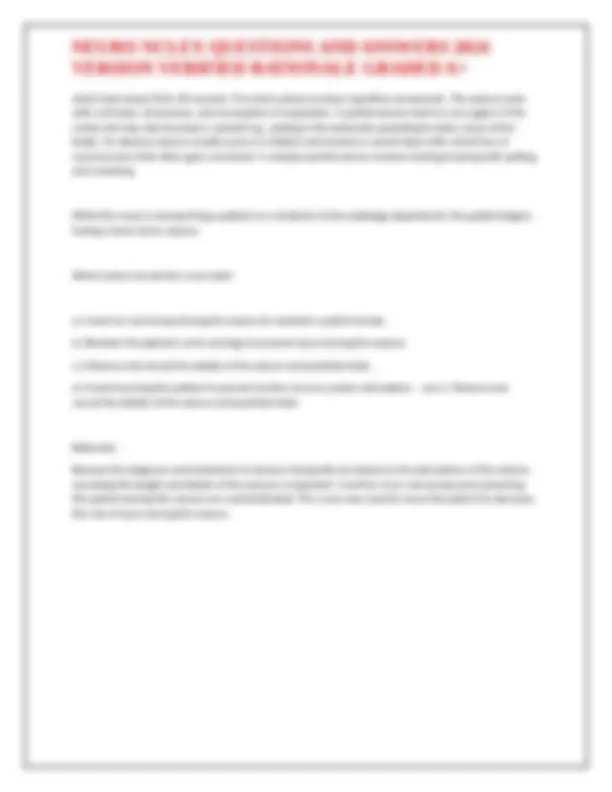


Study with the several resources on Docsity

Earn points by helping other students or get them with a premium plan


Prepare for your exams
Study with the several resources on Docsity

Earn points to download
Earn points by helping other students or get them with a premium plan
Community
Ask the community for help and clear up your study doubts
Discover the best universities in your country according to Docsity users
Free resources
Download our free guides on studying techniques, anxiety management strategies, and thesis advice from Docsity tutors
NEURO NCLEX QUESTIONS AND ANSWERS 2024 VERSION VERIFIED RATIONALE GRADED A+.docx
Typology: Exams
1 / 14

This page cannot be seen from the preview
Don't miss anything!









A 32-year-old patient has a stroke resulting from a ruptured aneurysm and subarachnoid hemorrhage. Which intervention will be included in the care plan? a. Applying intermittent pneumatic compression stockings b. Assisting to dangle on edge of bed and assess for dizziness c. Encouraging patient to cough and deep breathe every 4 hours d. Inserting an oropharyngeal airway to prevent airway obstruction - ansa. Applying intermittent pneumatic compression stockings Rationale: The patient with a subarachnoid hemorrhage usually has minimal activity to prevent cerebral vasospasm or further bleeding and is at risk for venous thromboemboism (VTE). Activities such as coughing and sitting up that might increase intracranial pressure (ICP) or decrease cerebral blood flow are avoided. Because there is no indication that the patient is unconscious, an oropharyngeal airway is inappropriate. A 58-year-old patient who began experiencing right-sided arm and leg weakness is admitted to the emergency department. In which order will the nurse implement these actions included in the stroke protocol? Put a comma and space between each answer choice (a, b, c, d, etc.) ____________________ a. Obtain CT scan without contrast. b. Infuse tissue plasminogen activator (tPA). c. Administer oxygen to keep O2 saturation >95%. d. Use National Institute of Health Stroke Scale to assess patient - ansIn this order: C, D, A, B Rationale: The initial actions should be those that help with airway, breathing, and circulation. Baseline neurologic assessments should be done next. A CT scan will be needed to rule out hemorrhagic stroke before tPA can be administered. A client asks if convulsions and seizures are the same. The nurse's response is based on the knowledge that:
a.) The terms can be used interchangeably. b.) Convulsions always involve violent skeletal muscle activity. c.) Seizures involve muscle spasms on one side only. d.) Seizure activity is more harmful than are convulsions. - ansb.) Convulsions always involve violent skeletal muscle activity. Rationale: Convulsions specifically refer to involuntary, violent spasms of the large muscles of the face, neck, arms, and legs. Seizure activity does not always involve these characteristics. A client has dysfunction of cranial nerve VIII. The nurse should determine that the client is adequately adapting to this problem if he or she states a plan to obtain which item? a.) A walker b.) Eyeglasses c.) A hearing aid d.) A bath thermometer e.) A hearing aid - anse.) A hearing aid A client has suffered damage to Broca's area of the brain. The nurse providing care for this client anticipates that which area will be affected? a.) Speech b.) Hearing c.) Balance d.) Level of consciousness - ansa.) Speech A client has sustained damage to Wernicke's area in the temporal lobe from a stroke (brain attack). The nurse anticipates that the client will have difficulty with which function?
A client with a neurological deficit is able, with eyes closed, to identify a set of keys placed in his or her hands. A nurse observing the client interprets this to mean that which area of the brain is intact? a.) Frontal lobe b.) Parietal lobe c.) Temporal lobe d.) Occipital lobe - ansb.) Parietal lobe A nurse is performing an assessment on a client with a head injury and notes that the client is assuming a posture that reflects a brainstem injury. The nurse contacts the health care provider and reports that the client is exhibiting which posture? a.) Decorticate rigidity b.) Opisthotonos c.) Decerebrate rigidity d.) Flaccid quadriplegia - ansa.) Decerebrate rigidity A patient comes to the emergency department immediately after experiencing numbness of the face and an inability to speak, but while the patient awaits examination, the symptoms disappear and the patient request discharge. The nurse stresses that it is important for the patient to be evaluated primarily because the patient has probably experienced a; a.) Transient ischemic attack b.) Ischemic stroke c.) Hemorrhagic stroke d.) MI - ansa.) Transient ischemic stroke Rationale: The patient has probably experienced a transient ischemic attack (TIA), which is a sign of progressive cerebral vascular disease- (A TIA is a temporary focal loss of neurologic function caused by ischemia of an area of the brain, usually lasting only about 3 hours. TIAs may be due to microemboli from heart
disease or carotid or cerebral thrombi and are a warning of progressive disease. Evaluation is necessary to determine the cause of the neurologic deficit and provide prophylactic treatment if possible.) A patient reports feeling numbness and tingling of the left arm before experiencing a tonic-clonic seizure. The nurse determines that this history is consistent with what type of seizure? a.) Focal b.) Atonic c.) Absence d.) Myoclonic - ansa.) Focal Rationale: The initial symptoms of a focal seizure involve clinical manifestations that are localized to a particular part of the body or brain. Symptoms of an absence seizure are staring and a brief loss of consciousness. In an atonic seizure, the patient loses muscle tone and (typically) falls to the ground. Myoclonic seizures are characterized by a sudden jerk of the body or extremities. A patient suffering from a recent stroke substitutes incorrect words and produces verbal responses in a monotone voice using short, slow phrases. These findings are consistent with? a.) Receptive aphasia b.) Expressive aphasia c.) Dysphasia d.) Global aphasia - ansb.) Expressive aphasia A patient who has had a subarachnoid hemorrhage is being cared for in the intensive care unit. Which information about the patient is most important to communicate to the health care provider? a. The patient's blood pressure is 90/50 mm Hg. b. The patient complains about having a stiff neck.
d. Difficulty in understanding commands - ansd. Difficulty in understanding commands Rationale: Right-sided paralysis indicates a left-brain stroke, which will lead to difficulty with comprehension and use of language. The left-side reflexes are likely to be intact. Impulsive behavior and neglect are more likely with a right-side stroke. A patient with right-sided weakness that started 90 minutes earlier is admitted to the emergency department and all these diagnostic tests are ordered. Which test should be done first? a. Electrocardiogram (ECG) b. Complete blood count (CBC) c. Chest radiograph (Chest x-ray) d. Noncontrast computed tomography (CT) scan - ansd. Noncontrast computed tomography (CT) scan Rationale: Rapid screening with a noncontrast CT scan is needed before administration of tissue plasminogen activator (tPA), which must be given within 4.5 hours of the onset of clinical manifestations of the stroke. The sooner the tPA is given, the smaller the area of brain injury. The other diagnostic tests give information about possible causes of the stroke and do not need to be completed as urgently as the CT scan. A patient with sudden-onset right-sided weakness has a CT scan and is diagnosed with an intracerebral hemorrhage. Which information about the patient is most important to communicate to the health care provider? a. The patient's speech is difficult to understand. b. The patient's blood pressure is 144/90 mm Hg. c. The patient takes a diuretic because of a history of hypertension. d. The patient has atrial fibrillation and takes warfarin (Coumadin). - ansd. The patient has atrial fibrillation and takes warfarin (Coumadin).
Rationale: The use of warfarin will have contributed to the intracerebral bleeding and remains a risk factor for further bleeding. Administration of vitamin K is needed to reverse the effects of the warfarin, especially if the patient is to have surgery to correct the bleeding. The history of hypertension is a risk factor for the patient but has no immediate effect on the patient's care. The BP of 144/90 indicates the need for ongoing monitoring but not for any immediate change in therapy. Slurred speech is consistent with a left-sided stroke, and no change in therapy is indicated. A student nurse is assisting with an assessment of a client's level of consciousness using the Glasgow Coma Scale. The student understands that which categories of client functioning are included in this assessment? Select all that apply. a.) Eye opening b.) Reflex response c.) Best verbal response d.) Best motor response e.) Pupil size and reaction - ansa.) Eye opening c.) Best verbal response d.) Best motor response Aspirin is ordered for a patient who is admitted with a possible stroke. Which information obtained during the admission assessment indicates that the nurse should consult with the health care provider before giving the aspirin? a. The patient has dysphasia. b. The patient has atrial fibrillation. c. The patient states, "My symptoms started with a terrible headache."
d.) Expect an orange discoloration of urine. - ansc.) Report unusual bleeding or bruises to the health care provider immediately. Rationale: Carbamazepine affects vitamin K metabolism, and can lead to blood dyscraisias and bleeding. It does not significantly lower blood sugar or change the color of body fluids. The nurse has instructed the family of a client with stroke (brain attack) who has homonymous hemianopsia about measures to help the client overcome the deficit. Which statement suggests that the family understands the measures to use when caring for the client? a.) "We need to discourage him from wearing eyeglasses." b.) "We need to place objects in his impaired field of vision." c.) "We need to approach him from the impaired field of vision." d.) "We need to remind him to turn his head to scan the lost visual field." - ansd.) "We need to remind him to turn his head to scan the lost visual field." The nurse is caring for an unconscious client who is experiencing persistent hyperthermia with no signs of infection. The nurse interprets that the hyperthermia may be related to damage to the client's thermoregulatory center in which structure? a.) Cerebrum b.) Cerebellum c.) Hippocampus d.) Hypothalamus - ansd.) Hypothalamus The nurse is developing a plan of care for a client with dysphagia following a stroke (brain attack). Which should the nurse include in the plan? Select all that apply.
a.) Thicken liquids. b.) Assist the client with eating. c.) Assess for the presence of a swallow reflex. d.) Place the food on the affected side of the mouth. e.) Provide ample time for the client to chew and swallow. - ansa.) Thicken liquids. b.) Assist the client with eating. c.) Assess for the presence of a swallow reflex. e.) Provide ample time for the client to chew and swallow. The nurse is documenting nursing observations in the record of a client who experienced a tonic-clonic seizure. Which clinical manifestation did the nurse most likely note in the clonic phase of the seizure? a.) Body stiffening b.) Spasms of the entire body c.) Sudden loss of consciousness d.) Brief flexion of the extremities - ansb.) Spasms of the entire body The nurse is planning to institute seizure precautions for a client who is being admitted from the emergency department. Which measures should the nurse include in planning for the client's safety? Select all that apply. a.) Padding the side rails of the bed b.) Placing an airway at the bedside c.) Placing the bed in the high position d.) Putting a padded tongue blade at the head of the bed e.) Placing oxygen and suction equipment at the bedside f.) Having intravenous equipment ready for insertion of an intravenous catheter - ansa.) Padding the side rails of the bed
Rationale: During the acute period, the nurse should place objects on the patient's unaffected side. Since there is a visual defect in the left half of each eye, an eye patch is not appropriate. The patient should be approached from the right side. The visual deficit may not resolve, although the patient can learn to compensate for the defect. Which intervention is most effective in minimizing the risk of seizure activity in a client who is undergoing diagnostic studies after having experienced several episodes of seizures? a.) Maintain the client on bed rest. b.) Administer butabarbital sodium (phenobarbital) 30 mg P.O., three times per day. c.) Close the door to the room to minimize stimulation. d.) Administer carbamazepine (Tegretol) 200 mg P.O., twice per day. - ansd.) Administer carbamazepine (Tegretol) 200 mg P.O., twice per day. Rationale: Carbamazepine (Tegretol) is an anticonvulsant that helps prevent further seizures. Bed rest, sedation (phenobarbital), and providing privacy do not minimize the risk of seizures. Which of the following will the nurse observe in the client in the ictal phase of a generalized tonic-clonic seizure? a.) Jerking in one extremity that spreads gradually to adjacent areas. b.) Vacant staring and abruptly ceasing all activity. c.) Facial grimaces, patting motions, and lip smacking. d.) Loss of consciousness, body stiffening, and violent muscle contractions. - ansa.) Jerking in one extremity that spreads gradually to adjacent areas. Rationale: The ictal phase of a generalized tonic-clonic seizure involves both a tonic phase and a clonic phase. The tonic phase consists of loss of consciousness, dilated pupils, and muscular stiffening or contraction,
which lasts about 20 to 30 seconds. The clonic phase involves repetitive movements. The seizure ends with confusion, drowsiness, and resumption of respiration. A partial seizure starts in one region of the cortex and may stay focused or spread (e.g., jerking in the extremity spreading to other areas of the body). An absence seizure usually occurs in children and involves a vacant stare with a brief loss of consciousness that often goes unnoticed. A complex partial seizure involves facial grimacing with patting and smacking. While the nurse is transporting a patient on a stretcher to the radiology department, the patient begins having a tonic-clonic seizure. Which action should the nurse take? a.) Insert an oral airway during the seizure to maintain a patent airway. b.) Restrain the patient's arms and legs to prevent injury during the seizure. c.) Observe and record the details of the seizure and postictal state. d.) Avoid touching the patient to prevent further nervous system stimulation. - ansc.) Observe and record the details of the seizure and postictal state. Rationale: Because the diagnosis and treatment of seizures frequently are based on the description of the seizure, recording the length and details of the seizure is important. Insertion of an oral airway and restraining the patient during the seizure are contraindicated. The nurse may need to move the patient to decrease the risk of injury during the seizure.